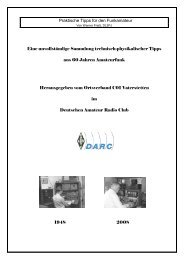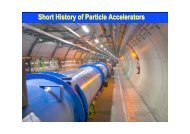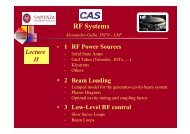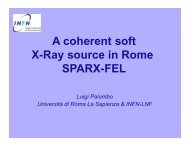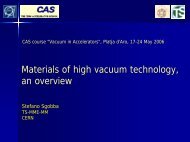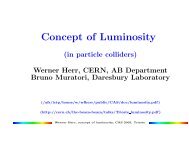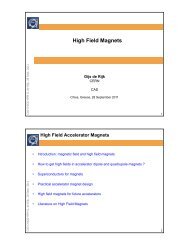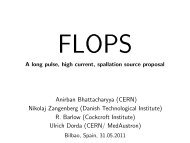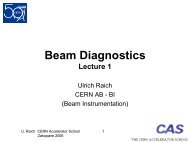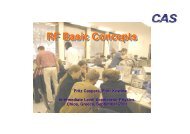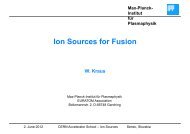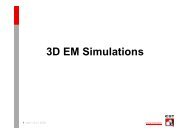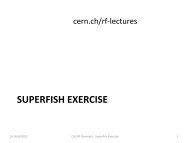Common Laplace Transform - CERN Accelerator School
Common Laplace Transform - CERN Accelerator School
Common Laplace Transform - CERN Accelerator School
Create successful ePaper yourself
Turn your PDF publications into a flip-book with our unique Google optimized e-Paper software.
Introduction to Feedback<br />
CAS <strong>Accelerator</strong> Physics, Sep 2007-S. Simrock<br />
1
Outline<br />
Feedback Systems in <strong>Accelerator</strong>s<br />
Concept of Feedback<br />
Modelling Dynamic Systems<br />
Analysis of Feedback<br />
Design of Feedback<br />
CAS <strong>Accelerator</strong> Physics, Sep 2007-S. Simrock<br />
2
Feedback Systems in <strong>Accelerator</strong>s<br />
Publications 2006/2007 in JACOW<br />
Commissioning of the LEP Transverse Feedback System<br />
Multi-bunch Feedback Activities at Photon Factory advanced Ring.<br />
State of the SLS Multi-bunch Feedback<br />
Real Time feedback on Beam parameters<br />
Computation of Wake fields and Impedances for the PETRA III<br />
Longitudinal Feedback Cavity<br />
The design and Performance of the prototype Digital Feedback RF<br />
Control System For the PLS Storage<br />
The P0 feedback Control System Blurs the Line between IOC and FPGA<br />
CAS <strong>Accelerator</strong> Physics, Sep 2007-S. Simrock<br />
3
Publications 2006/07 (C’tnd)<br />
Operation Experiences of the bunch feedback system for TLS<br />
Compensation of BPM Chamber Motion in PLS Orbit Feedback System<br />
LCLS RF Gun Feedback Control<br />
Comparison of ILC Fast Beam-Beam Feedback Performance in the e-eand<br />
e+e- Modes of Operation<br />
A Digital Ring Transverse feedback Low-Level RF Control System<br />
Performance of the New Coupled Bunch Feedback System at HERA-p<br />
Transverse Feedback Development at SOLEIL<br />
Reference: http://cernsearch.web.cern.ch/cernsearch/Default.aspx?query=doctype:application<br />
/pdf%20url:abstract%20url:accelconf/jacow%20url:accelconf%20title:feedback<br />
CAS <strong>Accelerator</strong> Physics, Sep 2007-S. Simrock<br />
4
Elettra fast orbit feedback:<br />
Examples (C’tnd)<br />
CAS <strong>Accelerator</strong> Physics, Sep 2007-S. Simrock<br />
5
Examples (C’tnd)<br />
Beam based feedback for tune, coupling and chromaticity<br />
CAS <strong>Accelerator</strong> Physics, Sep 2007-S. Simrock<br />
6
SLS Multi bunch Feedback :<br />
Examples (C’tnd)<br />
CAS <strong>Accelerator</strong> Physics, Sep 2007-S. Simrock<br />
7
1. Feedback Systems<br />
Objective:<br />
The Introduction of Feedback is concerned with the analysis and design of closed loop<br />
control systems.<br />
Analysis:<br />
Closed loop system is given determine characteristics or behavior.<br />
Design:<br />
Desired system characteristics or behavior are specified configure or synthesize closed<br />
loop system.<br />
Input<br />
Variable<br />
Plant<br />
sensor<br />
Variable<br />
Measurement of<br />
Variable<br />
Control-system components<br />
CAS <strong>Accelerator</strong> Physics, Sep 2007-S. Simrock<br />
8
1. Feedback Systems<br />
Definition:<br />
A closed-loop system is a system in which certain forces (we call these inputs) are<br />
determined, at least in part, by certain responses of the system (we call these outputs).<br />
System<br />
inputs<br />
O O<br />
Closed loop system<br />
CAS <strong>Accelerator</strong> Physics, Sep 2007-S. Simrock<br />
System<br />
outputs<br />
9
Definitions:<br />
The system for measurement of a variable (or signal) is called a sensor.<br />
A plant of a control system is the part of the system to be controlled.<br />
The compensator (or controller or simply filter) provides satisfactory<br />
characteristics for the total system.<br />
System<br />
input Error<br />
+<br />
Two types of control systems:<br />
1. Feedback Systems<br />
Compensator<br />
Sensor<br />
Manipulated<br />
variable<br />
Closed loop control system<br />
A regulator maintains a physical variable at some constant value in the<br />
presence of perturbances.<br />
A servomechanism describes a control system in which a physical variable is<br />
required to follow, or track some desired time function (originally applied in order to<br />
control a mechanical position or motion).<br />
CAS <strong>Accelerator</strong> Physics, Sep 2007-S. Simrock<br />
Plant<br />
System<br />
output<br />
10
Example 1: RF control system<br />
Goal:<br />
Maintain stable gradient and phase.<br />
Solution:<br />
Feedback for gradient amplitude and phase.<br />
~<br />
Phase<br />
controller<br />
Phase detector<br />
1. Feedback Systems<br />
amplitude<br />
controller Klystron<br />
Controller<br />
CAS <strong>Accelerator</strong> Physics, Sep 2007-S. Simrock<br />
+ -<br />
Gradient<br />
set point<br />
cavity<br />
continued…<br />
11
1. Feedback Systems<br />
Model:<br />
Mathematical description of input-output relation of components combined with block<br />
diagram.<br />
Amplitude loop (general form):<br />
Reference<br />
input<br />
_<br />
+<br />
error<br />
controller<br />
amplifier<br />
Klystron<br />
RF power<br />
amplifier<br />
Monitoring<br />
transducer<br />
Gradient detector<br />
CAS <strong>Accelerator</strong> Physics, Sep 2007-S. Simrock<br />
cavity<br />
plant<br />
output<br />
12
1. Feedback Systems<br />
RF control model using “transfer functions”<br />
Reference Input<br />
_<br />
Error<br />
A transfer function of a linear system is defined as the ratio of the <strong>Laplace</strong><br />
transform of the output and the <strong>Laplace</strong> transform of the input with I. C .’s =zero.<br />
Input<br />
E(s)<br />
controller<br />
R(s)<br />
+<br />
H c(<br />
s)<br />
Input-Output Relations<br />
Output<br />
CAS <strong>Accelerator</strong> Physics, Sep 2007-S. Simrock<br />
Transfer Function<br />
U(s) Y(s) G(s) = P(s)K(s)<br />
E(s) Y(s)<br />
Control input U(s)<br />
M(s)<br />
Klystron<br />
K(s)<br />
Gradient detector<br />
L(s) c<br />
= G(s)H (s)<br />
cavity<br />
P(s)<br />
R(s) −1<br />
Y(s) T(s) = ( 1 + L(s)M(s)) L(s)<br />
Output<br />
Y(s)<br />
13
Example2: Electrical circuit<br />
Differential equations:<br />
<strong>Laplace</strong> <strong>Transform</strong>:<br />
Transfer function:<br />
(t)<br />
V 1<br />
1. Feedback Systems<br />
i(t) R1<br />
1<br />
i(t) + R2<br />
i(t) + i()<br />
τ dτ = ν (t)<br />
C ∫<br />
t 0<br />
1<br />
R2 i(t) + i()<br />
τ dτ = ν2(t)<br />
C ∫<br />
R1 1<br />
0<br />
1<br />
I(s) + R2<br />
I(s) + I(s) = V (s)<br />
s ⋅C<br />
1<br />
R2 I(s) + I(s) = V2(s)<br />
s ⋅C<br />
R1 1<br />
V2(s)<br />
R2<br />
⋅C<br />
⋅ s + 1<br />
G(s) = =<br />
V (s) (R + R )C ⋅ s + 1<br />
1<br />
1<br />
CAS <strong>Accelerator</strong> Physics, Sep 2007-S. Simrock<br />
t<br />
2<br />
R2<br />
C<br />
(t)<br />
V 2<br />
Input V1<br />
,output V2<br />
14
1. Feedback Systems<br />
Example 3: Circuit with operational amplifier<br />
Vi<br />
i 1<br />
1<br />
R 2<br />
+ -<br />
.<br />
i (s) = R1I<br />
(s) and ⎛ 1 ⎞<br />
Vo(s) = −⎜<br />
R2<br />
+ ⎟I1(s) ⎝ s ⋅C<br />
⎠<br />
V0(s)<br />
R2<br />
⋅C<br />
⋅ s + 1<br />
G(s) = = −<br />
V (s) R ⋅C<br />
⋅ s<br />
V 1<br />
i<br />
It is convenient to derive a transfer function for a circuit with a single operational<br />
amplifier that contains input and feedback impedance:<br />
I(s)<br />
(s)<br />
Z i<br />
R<br />
1<br />
CAS <strong>Accelerator</strong> Physics, Sep 2007-S. Simrock<br />
+ -<br />
(s)<br />
Z f<br />
Vi (s)<br />
Vo(s) (s) = Z (s) I(s) and<br />
Vi i<br />
.<br />
C<br />
Vo(s) = −Z<br />
f (s) I(s)<br />
Vo<br />
V (s)<br />
G(s) = =<br />
V (s)<br />
o −<br />
i<br />
Z<br />
f<br />
(s)<br />
Z (s)<br />
i<br />
15
2. Model of Dynamic System<br />
We will study the following dynamic system:<br />
Parameters:<br />
γ k<br />
k<br />
γ<br />
: spring constant<br />
: damping constant<br />
m = 1<br />
u(t)<br />
y(t)<br />
u(t) : force<br />
Quantity of interest:<br />
y(t) : displacement from equilibrium<br />
Differential equation: Newton’s third law m = 1<br />
( )<br />
( t)<br />
= ∑ F = −k<br />
y(<br />
t)<br />
− γ y&<br />
( t)<br />
u(<br />
t)<br />
&y<br />
&()<br />
t + γ y&<br />
() t + k y()<br />
t = u()<br />
t<br />
y( 0)<br />
= y0<br />
, y&<br />
( 0)<br />
= y&<br />
0<br />
&y<br />
&<br />
ext +<br />
-Equation is linear (i.e. no like terms).<br />
-Ordinary (as opposed to partial e.g. )<br />
-All coefficients constant:<br />
2<br />
y&<br />
=<br />
∂ ∂<br />
∂x<br />
∂t<br />
k t = κ ,γ t =<br />
( ) ( ) γ<br />
( x,t)<br />
= 0<br />
CAS <strong>Accelerator</strong> Physics, Sep 2007-S. Simrock<br />
f<br />
for all t<br />
16
Stop calculating, let’s paint!!!<br />
2. Model of Dynamic System<br />
1. Express highest order term (put it to one side)<br />
2. Putt adder in front<br />
Picture to visualize differential equation<br />
( t)<br />
= −k<br />
y(<br />
t)<br />
− γ y&<br />
( t)<br />
u(<br />
t)<br />
&y<br />
&<br />
+<br />
u ( t)<br />
− k y(<br />
t)<br />
3. Synthesize all other terms using integrators!<br />
u () t<br />
+<br />
-<br />
-<br />
&y&<br />
( t)<br />
+<br />
Block diagram<br />
t<br />
&y&<br />
( t)<br />
− γ y&<br />
( t)<br />
( )<br />
∫ ∫<br />
γ<br />
y&<br />
y(<br />
t)<br />
k<br />
CAS <strong>Accelerator</strong> Physics, Sep 2007-S. Simrock<br />
17
2.1 Linear Ordinary Differential Equation (LODE)<br />
Most important for control system/feedback design:<br />
( n−1)<br />
() t + a y () t<br />
( m ) ( t)<br />
+ a y(t) = b u () t + ... + b u&<br />
( t)<br />
+ b u(<br />
t)<br />
(n)<br />
y n 1 + ... + a1<br />
y&<br />
0<br />
m<br />
1<br />
0<br />
−<br />
In general: given any linear time invariant system described by LODE can be<br />
realized/simulated/easily visualized in a block diagram n = 2,<br />
m = 2<br />
u()<br />
t<br />
+<br />
-<br />
-<br />
b2<br />
a1<br />
Control-canonical form<br />
x2<br />
b1<br />
a0<br />
Very useful to visualize interaction between variables!<br />
What are and ????<br />
x<br />
x1 2<br />
∫<br />
∫<br />
x1<br />
( )<br />
b0<br />
More explanation later, for now: please simply accept it!<br />
CAS <strong>Accelerator</strong> Physics, Sep 2007-S. Simrock<br />
+<br />
+<br />
+<br />
y(<br />
t)<br />
18
2.2 State Space Equation<br />
Any system which can be presented by LODE can be represented in State space<br />
form (matrix differential equation).<br />
What do we have to do ???<br />
Let’s go back to our first example (Newton’s law):<br />
1. STEP:<br />
( t)<br />
+ γ y&<br />
( t)<br />
+ k y(<br />
t)<br />
u(<br />
t)<br />
&y<br />
&<br />
=<br />
Deduce set off first order differential equation in variables<br />
x j () t<br />
x1()≅ t<br />
x2()≅ t<br />
x&<br />
x&<br />
1<br />
2<br />
(so-called states of system)<br />
Position :<br />
Velocity : :<br />
() t = y&<br />
() t = x () t<br />
2<br />
y(<br />
t)<br />
y&<br />
() t = &y<br />
&()<br />
t = −k<br />
y()<br />
t − γ y&<br />
() t + u()<br />
t<br />
= −k<br />
x () t − γ x () t + u()<br />
t<br />
1<br />
( t)<br />
2<br />
One LODE of order n transformed into n LODEs of order 1<br />
CAS <strong>Accelerator</strong> Physics, Sep 2007-S. Simrock<br />
19
2. STEP:<br />
2.2 State Space Equation<br />
Put everything together in a matrix differential equation:<br />
⎡x&<br />
⎢<br />
⎣x&<br />
y<br />
Definition:<br />
1<br />
2<br />
() t<br />
() t<br />
⎤ ⎡0<br />
1⎤<br />
⎡x1<br />
⎥ = ⎢<br />
-k - γ<br />
⎥ ⎢<br />
⎦ ⎣ ⎦ ⎣x<br />
2<br />
() t = [ 1 0]<br />
⎡ x<br />
⎢<br />
⎣ x<br />
1<br />
2<br />
( t )<br />
() t<br />
⎤<br />
⎥<br />
⎦<br />
( t)<br />
() t<br />
⎤ ⎡0⎤<br />
⎥ + ⎢<br />
1<br />
⎥<br />
⎦ ⎣ ⎦<br />
u()<br />
t<br />
( t)<br />
= A x(<br />
t)<br />
B u ( t)<br />
x & +<br />
( t)<br />
= C x(<br />
t)<br />
D u(<br />
t)<br />
y +<br />
State equation<br />
Measurement equation<br />
The system state x<br />
of a system at any time t0<br />
is the “amount of information” that,<br />
together with all inputs for t ≥ t , uniquely determines the behaviour of the system<br />
0<br />
for all t ≥ t .<br />
0<br />
CAS <strong>Accelerator</strong> Physics, Sep 2007-S. Simrock<br />
20
2.2 State Space Equation<br />
The linear time-invariant (LTI) analog system is described via<br />
Standard form of the State Space Equation<br />
⎡x1<br />
t ⎤<br />
x()<br />
t<br />
⎢ ⎥<br />
Where x& () t is the time derivative of the vector =<br />
⎢<br />
⋅⋅⋅<br />
⎥<br />
.<br />
⎢⎣<br />
xn()<br />
t ⎥⎦<br />
Declaration of variables<br />
x<br />
t0<br />
System completely described by state space matrixes ( in the most cases D = ).<br />
Variable Dimension Name<br />
X () t<br />
A<br />
B<br />
u()<br />
t<br />
y()<br />
t<br />
C<br />
D<br />
( t)<br />
= A x(<br />
t)<br />
B u(<br />
t)<br />
x & + State equation<br />
( t)<br />
C x(<br />
t)<br />
D u(<br />
t)<br />
y = + Measurement equation<br />
n× 1<br />
n× n<br />
n× r<br />
r × 1<br />
p× 1<br />
p × n<br />
p × r<br />
()<br />
CAS <strong>Accelerator</strong> Physics, Sep 2007-S. Simrock<br />
And starting conditions ( )<br />
A, B, C, D 0<br />
state vector<br />
system matrix<br />
input matrix<br />
input vector<br />
output vector<br />
output matrix<br />
matrix representing direct coupling<br />
between input and output<br />
21
2.2 State Space Equation<br />
Why all this work with state space equation? Why bother with?<br />
BECAUSE: Given any system of the LODE form<br />
( n ) ( n−1<br />
) ( m ) () t + a y ( t)<br />
+ ... + a y&<br />
( t)<br />
+ a y(<br />
t)<br />
= b u ( t)<br />
+ ... + b u&<br />
( t)<br />
+ b u(<br />
t)<br />
y n−1<br />
1<br />
0<br />
m<br />
1<br />
0<br />
Can be represented as<br />
x&<br />
y<br />
( t)<br />
= A x(<br />
t)<br />
+ B u ( t)<br />
() t = C x()<br />
t + D u () t<br />
with e.g. Control-Canonical Form (case n =<br />
3 ,m = 3 ):<br />
⎡ 0<br />
A =<br />
⎢<br />
⎢<br />
0<br />
⎢⎣<br />
− a0<br />
1<br />
0<br />
− a1<br />
0 ⎤ ⎡0⎤<br />
1<br />
⎥<br />
, B<br />
⎢<br />
0<br />
⎥<br />
⎥<br />
=<br />
⎢ ⎥<br />
, C =<br />
− a ⎥ ⎢<br />
2 ⎦ ⎣1⎥⎦<br />
=<br />
or Observer-Canonical Form:<br />
⎡0<br />
0 − a0<br />
⎤ ⎡b0<br />
⎤<br />
A =<br />
⎢<br />
1 0 a<br />
⎥<br />
1 ,B<br />
⎢<br />
b<br />
⎥<br />
⎢<br />
−<br />
⎥<br />
=<br />
⎢ 1 ⎥<br />
,C = =<br />
⎢⎣<br />
0 1 − a ⎥ ⎢<br />
2 ⎦ ⎣b<br />
⎥ 2 ⎦<br />
Notation is very compact, But: not unique!!!<br />
Computers love state space equation! (Trust us!)<br />
Modern control (1960-now) uses state space equation.<br />
General (vector) block diagram for easy visualization.<br />
CAS <strong>Accelerator</strong> Physics, Sep 2007-S. Simrock<br />
[ b0<br />
b1<br />
b2<br />
] , D b3<br />
[ 0 0 1]<br />
,D b3<br />
22
2.2 State Space Equation<br />
Now: Solution of State Space Equation in the time domain. Out of the hat…et voila:<br />
x<br />
t<br />
() t Φ()<br />
t x(<br />
0)<br />
+ Φ(<br />
τ)<br />
B u(<br />
t − τ)<br />
dτ<br />
= ∫<br />
Natural Response + Particular Solution<br />
y<br />
() t = C x()<br />
t + D u(<br />
t)<br />
= C Φ<br />
With the state transition matrix<br />
Φ<br />
() t<br />
3.Φ<br />
4.Φ<br />
=<br />
dΦ<br />
1.<br />
dt<br />
2.Φ<br />
I<br />
() t<br />
0<br />
t<br />
() t x(<br />
0)<br />
+ C Φ(<br />
τ)<br />
B u(<br />
t − τ)<br />
dτ + D u()<br />
t<br />
+ At +<br />
=<br />
A Φ<br />
2<br />
A<br />
2!<br />
() t<br />
t<br />
2<br />
+<br />
( 0)<br />
= I<br />
( t1<br />
+ t2<br />
) = Φ(<br />
t1<br />
) ⋅Φ(<br />
t2<br />
)<br />
−1()<br />
t = Φ(<br />
− t)<br />
∫<br />
0<br />
3<br />
A<br />
3!<br />
t<br />
3<br />
+ ... = e<br />
A t<br />
Exponential series in the matrix A (time evolution operator) properties of Φ t (state transition matrix).<br />
Example:<br />
⎡0<br />
A = ⎢<br />
⎣0<br />
1⎤<br />
⇒<br />
0<br />
⎥<br />
⎦<br />
A<br />
2<br />
⎡0<br />
= ⎢<br />
⎣0<br />
0⎤<br />
, Φ<br />
0<br />
⎥<br />
⎦<br />
() t<br />
=<br />
I<br />
⎡1<br />
t ⎤ A t<br />
+ At = ⎢ = e<br />
0 1<br />
⎥<br />
⎣ ⎦<br />
Matrix A is a nilpotent matrix.<br />
CAS <strong>Accelerator</strong> Physics, Sep 2007-S. Simrock<br />
( )<br />
23
Continuous-time state space model<br />
y<br />
2.4 Transfer Function G (s)<br />
() t = A x(<br />
t)<br />
+ B u(<br />
t)<br />
() t = C x()<br />
t + D u()<br />
t<br />
x&<br />
State equation<br />
Measurement equation<br />
Transfer function describes input-output relation of system.<br />
U () s<br />
X<br />
Y<br />
System<br />
( s)<br />
− x(<br />
0)<br />
= A X(<br />
s)<br />
B U(<br />
s)<br />
s X +<br />
−1<br />
−1<br />
( s)<br />
= ( sI − A)<br />
x(<br />
0)<br />
+ ( sI − A)<br />
B U ( s)<br />
= Φ()<br />
s x()<br />
0 + Φ()<br />
s B U () s<br />
( s)<br />
= C X ( s)<br />
+ D U ( s)<br />
−1<br />
−1<br />
= C[ ( sI − A)<br />
]x(<br />
0)<br />
+ [c(<br />
sI − A)<br />
B + D]U ( s)<br />
= C Φ()<br />
s x()<br />
0 + C Φ()<br />
s B U () s + D U () s<br />
( )<br />
−1<br />
( s)<br />
= C(<br />
sI − A)<br />
B + D = C Φ(<br />
s)<br />
B D<br />
G +<br />
CAS <strong>Accelerator</strong> Physics, Sep 2007-S. Simrock<br />
Y(<br />
s)<br />
Transfer function G<br />
s ( pxr ) (case: x(0)=0):<br />
24
2.4 Transfer Function of a Closed Loop System<br />
R () s () s<br />
E U ( s)<br />
Y(<br />
s)<br />
Hc ( s)<br />
G(<br />
s)<br />
-<br />
Y<br />
M(<br />
s)<br />
We can deduce for the output of the system.<br />
() s<br />
() s = G(<br />
s)<br />
U ( s)<br />
= G(<br />
s)<br />
H c ( s)<br />
E(<br />
s)<br />
= G()<br />
s H c () s [ R()<br />
s − M () s Y () s ]<br />
= L()<br />
s R()<br />
s − L()<br />
s M () s Y () s<br />
With L the transfer function of the open loop system (controller plus plant).<br />
( I + L(<br />
s)<br />
M ( s)<br />
) Y ( s)<br />
= L(<br />
s)<br />
R(<br />
s)<br />
−1<br />
Y () s = ( I + L()<br />
s M () s ) L(<br />
s)<br />
R(<br />
s)<br />
= T () s R()<br />
s<br />
T () s is called : Reference Transfer Function<br />
CAS <strong>Accelerator</strong> Physics, Sep 2007-S. Simrock<br />
25
e<br />
2.5 Sensitivity and Disturbance Rejection<br />
Consider the following closed loop system:<br />
The controlled output :<br />
substituting :<br />
yields :<br />
C ( s )<br />
u<br />
y = Gu + d<br />
u = C(<br />
r − y − n)<br />
y = ( I + GC)<br />
Now define the transfer functions for:<br />
Sensitivity:<br />
Complementary<br />
Sensitivity:<br />
d<br />
G ( s )<br />
y<br />
−1<br />
S(<br />
s)<br />
= ( I + G(<br />
s)<br />
C(<br />
s))<br />
T(s) = (I + G(s)C(s))<br />
GC(<br />
r − n)<br />
+ ( I + GC)<br />
−1<br />
−1<br />
G(s)C(s)<br />
CAS <strong>Accelerator</strong> Physics, Sep 2007-S. Simrock<br />
n<br />
−1<br />
d<br />
r(t) - reference input<br />
d(t) – output disturbance<br />
n(t) – measurement noise<br />
y(t) – controlled output<br />
T +<br />
S =<br />
I<br />
26
2.5 Sensitivity and Disturbance Rejection (C’tnd)<br />
Controller Design objectives are:<br />
• Tracking: output should follow reference<br />
y ( t)<br />
= r(<br />
t)<br />
• Disturbance rejection: controller should keep the<br />
controlled output at it desired value<br />
d(<br />
t)<br />
≅<br />
• Noise rejection: suppressing measurement noise<br />
n(<br />
t)<br />
≅<br />
• Reasonable control effort: must achieve given<br />
constraints of the actuator system<br />
0<br />
0<br />
CAS <strong>Accelerator</strong> Physics, Sep 2007-S. Simrock<br />
T ( s)<br />
=<br />
T ( s)<br />
=<br />
I<br />
I<br />
S(<br />
s)<br />
=<br />
S(<br />
s)<br />
=<br />
0<br />
0<br />
T( s)<br />
= 0 S ( s)<br />
= I<br />
It turns out that perfect tracking and disturbance rejection on the one hand,<br />
and noise rejection on the other hand are conflicting design objectives.<br />
Goal: Find the best trade-off between all to find the<br />
optimal controller for your application!<br />
27
2.7 Poles and Zeroes<br />
Can stability be determined if we know the TF of a system?<br />
g<br />
ij<br />
G<br />
() s<br />
() s = C Φ()<br />
s<br />
∏<br />
= α ⋅<br />
∏<br />
m<br />
k = 1<br />
n<br />
l=<br />
1<br />
B + D = C<br />
( s − zk<br />
)<br />
( s − p )<br />
l<br />
=<br />
N<br />
D<br />
ij<br />
ij<br />
[ sI − A]<br />
χ()<br />
s<br />
( s)<br />
() s<br />
adj<br />
B + D<br />
Coefficients of Transfer function G(s) are rational functions in the complex variable s<br />
zk l<br />
p α m ≤ n<br />
zeroes. poles, real constant, and it is (we assume common factors have<br />
already been canceled!)<br />
What do we know about the zeros and the poles?<br />
N () s<br />
D(<br />
s)<br />
Since numerator and denominator are polynomials with real coefficients,<br />
Ploes and zeroes must be real numbers or must arise as complex conjugated pairs!<br />
CAS <strong>Accelerator</strong> Physics, Sep 2007-S. Simrock<br />
28
Stability directly from state-space<br />
2.7 Poles and Zeroes<br />
Recall<br />
: H<br />
Assuming D=0 (D could change zeros but not poles)<br />
( )<br />
−1<br />
( s)<br />
= C(<br />
sI − A)<br />
B + D<br />
C sI − A adjB<br />
b s<br />
H () s = =<br />
det(<br />
sI − A)<br />
a()<br />
s<br />
Assuming there are no common factors between the poly Cadj( sI − A)B<br />
and det( sI − A)<br />
i.e. no pole-zero cancellations (usually true, system called “ minimal” ) then we can identify<br />
and<br />
i.e. poles are root of det ( sI−<br />
A)<br />
i<br />
( s)<br />
= C ( sI − A)<br />
B<br />
b adj<br />
( s)<br />
= det ( sI A)<br />
a −<br />
th<br />
Let λ be the i eigenvalue of A<br />
Re<br />
{λ i<br />
} ≤ 0 for all i<br />
( )<br />
=><br />
if System stable<br />
So with computer, with eigenvalue solver, can determine system stability directly from coupling matrix A.<br />
CAS <strong>Accelerator</strong> Physics, Sep 2007-S. Simrock<br />
29
2.8 Stability Criteria<br />
A system is BIBO stable if, for every bounded input, the output remains bounded with<br />
Increasing time.<br />
For a LTI system, this definition requires that all poles of the closed-loop transfer-function<br />
(all roots of the system characteristic equation) lie in the left half of the complex plane.<br />
Several methods are available for stability analysis:<br />
1. Routh Hurwitz criterion<br />
2. Calculation of exact locations of roots<br />
a. Root locus technique<br />
b. Nyquist criterion<br />
c. Bode plot<br />
3. Simulation (only general procedures for nonlinear systems)<br />
While the first criterion proofs whether a feedback system is stable or unstable,<br />
the second Method also provides information about the setting time (damping term).<br />
CAS <strong>Accelerator</strong> Physics, Sep 2007-S. Simrock<br />
30
2.8 Poles and Zeroes<br />
Pole locations tell us about impulse response i.e. also stability:<br />
Medium oscillation<br />
Medium decay<br />
X<br />
No Oscillation<br />
Fast Decay<br />
X<br />
X<br />
Im (s) =<br />
ω<br />
X<br />
X X<br />
X<br />
No oscillation<br />
No growth<br />
S-Plane<br />
X<br />
X<br />
CAS <strong>Accelerator</strong> Physics, Sep 2007-S. Simrock<br />
Fast oscillation<br />
No growth<br />
Medium oscillation<br />
Medium growth<br />
Re (s) =<br />
σ<br />
No oscillation<br />
Fast growth<br />
31
2.8 Poles and Zeroes<br />
Furthermore: Keep in mind the following picture and facts!<br />
Complex pole pair: Oscillation with growth or decay.<br />
Real pole: exponential growth or decay.<br />
Poles are the Eigenvalues of the matrix A.<br />
Position of zeros goes into the size of c j ....<br />
In general a complex root must have a corresponding conjugate root ( N(s), D(S) polynomials<br />
with real coefficients.<br />
CAS <strong>Accelerator</strong> Physics, Sep 2007-S. Simrock<br />
32
0<br />
0<br />
dB<br />
0<br />
−90<br />
0<br />
−180<br />
Phase Margin<br />
2.8 Bode Diagram<br />
ω2<br />
φ m<br />
Gm<br />
ω1<br />
ω2 1 ω<br />
CAS <strong>Accelerator</strong> Physics, Sep 2007-S. Simrock<br />
Gain Margin<br />
The closed loop is stable if the phase of the unity crossover frequency of the OPEN LOOP<br />
Is larger than-180 degrees.<br />
ω<br />
ω<br />
33
2.8 Root Locus Analysis<br />
Definition: A root locus of a system is a plot of the roots of the system characteristic<br />
Equation (the poles of the closed-loop transfer function) while some parameter of the<br />
system (usually the feedback gain) is varied.<br />
K H<br />
() s<br />
=<br />
R () s<br />
X<br />
p<br />
3<br />
( s − p ) ( s − p ) ( s − p )<br />
+<br />
-<br />
1<br />
K<br />
X<br />
p<br />
2<br />
2<br />
K<br />
3<br />
G CL<br />
X<br />
p<br />
1<br />
() s<br />
K H<br />
=<br />
1+<br />
K H<br />
( s)<br />
() s<br />
H () s<br />
roots at 1+<br />
K H()<br />
s = 0.<br />
How do we move the poles by varying the constant gain K?<br />
CAS <strong>Accelerator</strong> Physics, Sep 2007-S. Simrock<br />
Y ( s)<br />
34
X<br />
p<br />
2<br />
O<br />
z<br />
1<br />
X<br />
p<br />
1<br />
X<br />
p<br />
1<br />
1<br />
s − p<br />
(a)<br />
1<br />
2.8 Root Locus Analysis<br />
s − z<br />
( s − p )( s − p )<br />
(c)<br />
1<br />
1<br />
2<br />
X<br />
p<br />
CAS <strong>Accelerator</strong> Physics, Sep 2007-S. Simrock<br />
2<br />
O<br />
z<br />
1<br />
X<br />
p<br />
2<br />
X<br />
p<br />
X<br />
p<br />
1<br />
1<br />
( s − p )( s − p )<br />
(b)<br />
1<br />
1<br />
s − z<br />
2<br />
( s − p )( s − p )<br />
(d)<br />
1<br />
1<br />
2<br />
35
X<br />
p<br />
3<br />
p2<br />
X<br />
X<br />
p<br />
3<br />
X<br />
p<br />
2<br />
X<br />
p<br />
1<br />
X<br />
p<br />
1<br />
( s − p )( s − p )( s − p )<br />
(e)<br />
1<br />
1<br />
( s − p )( s − p )( s − p )<br />
(g)<br />
2.8 Root Locus Analysis (Cnt’d)<br />
1<br />
1<br />
2<br />
2<br />
3<br />
3<br />
X<br />
p2<br />
X<br />
X<br />
p<br />
X<br />
CAS <strong>Accelerator</strong> Physics, Sep 2007-S. Simrock<br />
3<br />
O<br />
p3 p2<br />
1 z<br />
X<br />
p<br />
X<br />
p<br />
1<br />
1<br />
( s − p )( s − p )( s − p )<br />
(f)<br />
1<br />
1<br />
( s − p )( s − p )( s − p )<br />
(h)<br />
1<br />
s − z<br />
2<br />
1<br />
2<br />
36<br />
3<br />
3
The idea:<br />
Suppose we have a system or “plant”<br />
3. Feedback<br />
We want to improve some aspect of plant’s performance by observing the output<br />
and applying a appropriate “correction” signal. This is feedback<br />
U feedback<br />
Question: What should this be?<br />
r<br />
plant<br />
plant<br />
?<br />
“open loop”<br />
CAS <strong>Accelerator</strong> Physics, Sep 2007-S. Simrock<br />
“closed loop”<br />
37
Open loop gain:<br />
Closed-loop gain:<br />
u<br />
3. Feedback<br />
u y<br />
G(s)<br />
U<br />
fb<br />
G<br />
Pr oof: y = G<br />
O.L<br />
() s = G()<br />
s<br />
G (s)<br />
C.L<br />
G(s)<br />
H (s)<br />
( u − u )<br />
fb<br />
= G u − G u<br />
= G u − G Hy<br />
=<br />
⎛<br />
⎜<br />
⎝<br />
u<br />
y<br />
⎟<br />
⎠<br />
−1<br />
CAS <strong>Accelerator</strong> Physics, Sep 2007-S. Simrock<br />
⎞<br />
G(s)<br />
=<br />
1+<br />
G(s) H(s)<br />
fb<br />
y<br />
⇒ y + G H<br />
⇒<br />
“closed loop”<br />
y<br />
u<br />
=<br />
y<br />
= G u<br />
G<br />
( 1+<br />
G H )<br />
38
3.1 Feedback-Example 1<br />
Consider S.H.O with feedback proportional to x i.e.:<br />
Where<br />
Then<br />
U<br />
-<br />
&x<br />
&+<br />
γ x&<br />
+ ω<br />
u<br />
fb<br />
1<br />
+ - s<br />
-<br />
2<br />
n<br />
x = u + u<br />
() t = −α<br />
x () t<br />
&x& x& x<br />
γ<br />
&x<br />
&+<br />
γ x&<br />
+ ω<br />
2<br />
n<br />
==> &x<br />
& + γ x&<br />
+<br />
x = u−<br />
α x<br />
Same as before, except that new “natural” frequency ω α<br />
2<br />
n +<br />
fb<br />
1<br />
s<br />
2<br />
ω n<br />
2 ( ω + α)<br />
x = u<br />
n<br />
CAS <strong>Accelerator</strong> Physics, Sep 2007-S. Simrock<br />
α<br />
y<br />
39
Now the closed loop T.F. is:<br />
ω 2<br />
n<br />
1<br />
ω<br />
2<br />
n<br />
dB<br />
1<br />
+ α<br />
3.1 Feedback-Example 1<br />
() s<br />
C.L.<br />
G = 2<br />
2<br />
s + γs + n<br />
G ( iω)<br />
O.L.<br />
G ( iω)<br />
C.L.<br />
log ω<br />
2<br />
n log ωn<br />
α +<br />
DC response: s=0<br />
( ω + α )<br />
So the effect of the proportional feedback in this case is to increase the bandwidth<br />
of the system<br />
(and reduce gain slightly, but this can easily be compensated by adding a constant gain in front…)<br />
1<br />
CAS <strong>Accelerator</strong> Physics, Sep 2007-S. Simrock<br />
log(ω)<br />
40
u<br />
3.1 Feedback-Example 2<br />
In S.H.O. suppose we use integral feedback:<br />
t<br />
fb ∫<br />
0<br />
() t = −α<br />
x(<br />
τ)dτ<br />
∫<br />
() τ<br />
2<br />
i.e &x<br />
&+<br />
γ x&<br />
+ ωn<br />
x = u − α x dτ<br />
U &x& x&<br />
1<br />
x<br />
-<br />
1<br />
+ - s<br />
-<br />
γ<br />
2<br />
Differentiating once more yields: x γ x ω x α x u<br />
t<br />
0<br />
& + &<br />
+ & + =<br />
No longer just simple S.H.O., add another state<br />
α<br />
s<br />
2<br />
ω n<br />
CAS <strong>Accelerator</strong> Physics, Sep 2007-S. Simrock<br />
s<br />
n<br />
&<br />
y<br />
41
1<br />
2<br />
ω n<br />
dB<br />
G<br />
C.L.<br />
() s<br />
G ( iω)<br />
O.L.<br />
G ( iω)<br />
C.L.<br />
3.1 Feedback-Example 2<br />
1<br />
2<br />
s + γs + ω<br />
=<br />
⎛ α ⎞⎛<br />
1<br />
1 + ⎜ ⎟ 2<br />
s ⎜<br />
⎝ ⎠⎝<br />
s + γs +<br />
s<br />
=<br />
s<br />
2<br />
2 ( s + γs + ω ) + α<br />
n<br />
2<br />
n<br />
2 ( ω + α)<br />
n<br />
⎞<br />
⎟<br />
⎠<br />
CAS <strong>Accelerator</strong> Physics, Sep 2007-S. Simrock<br />
Observe that<br />
1. G ( 0 0)<br />
2. For large s (and hence for large )<br />
C.L.<br />
=<br />
ω<br />
G<br />
log(ω)<br />
C.L.<br />
() s<br />
≈<br />
1<br />
2<br />
2 ( s + γs + ω )<br />
n<br />
≈<br />
G<br />
O.L.<br />
() s<br />
So integral feedback has killed DC gain<br />
i.e system rejects constant disturbances<br />
42
3.1 Feedback-Example 3<br />
Suppose S.H.O now apply differential feedback i.e.<br />
Now have<br />
-<br />
+<br />
-<br />
-<br />
u fb<br />
( t)<br />
= −α<br />
x&<br />
( t)<br />
&x& x& 1 x<br />
1<br />
s<br />
γ<br />
α x&<br />
αS<br />
2<br />
( γ α)<br />
x ω x u + +<br />
x + &<br />
&<br />
2<br />
ω n<br />
n =<br />
So effect off differential feedback is to increase damping<br />
x<br />
s<br />
CAS <strong>Accelerator</strong> Physics, Sep 2007-S. Simrock<br />
43
C.L.<br />
Now G () s<br />
1<br />
2<br />
ω n<br />
dB<br />
3.1 Feedback-Example 3<br />
=<br />
s<br />
2<br />
G ( iω)<br />
O.L.<br />
+<br />
1<br />
2<br />
( γ + α ) s + ω<br />
G ( iω)<br />
C.L.<br />
CAS <strong>Accelerator</strong> Physics, Sep 2007-S. Simrock<br />
n<br />
log(ω)<br />
So the effect of differential feedback here is to “flatten the resonance” i.e. damping is increased.<br />
Note: Differentiators can never be built exactly, only approximately.<br />
44
fb<br />
3.1 PID Controller<br />
(1) The latter 3 examples of feedback can all be combined to form a<br />
P.I.D. controller (prop.-integral-diff).<br />
u = u + u + u<br />
p<br />
d<br />
u<br />
l<br />
-<br />
+<br />
S.H.O<br />
P.I.D controller<br />
K p + K D s + K l /s<br />
(2) In example above S.H.O. was a very simple system and it was clear what physical<br />
interpretation of P. or I. or D. did. But for large complex systems not obvious<br />
==> Require arbitrary “ tweaking ”<br />
That’s what we’re trying to avoid<br />
CAS <strong>Accelerator</strong> Physics, Sep 2007-S. Simrock<br />
x =<br />
y<br />
45
G<br />
3.1 PID Controller<br />
For example, if you are so smart let’s see you do this with your P.I.D. controller:<br />
6 th order system<br />
3 resonant poles<br />
3 complex pairs<br />
6 poles<br />
Damp this mode, but leave the other two modes undamped, just as they are.<br />
This could turn out to be a tweaking nightmare that’ll get you nowhere fast!<br />
With modern control theory this problem can be solved easily.<br />
CAS <strong>Accelerator</strong> Physics, Sep 2007-S. Simrock<br />
ω<br />
46



